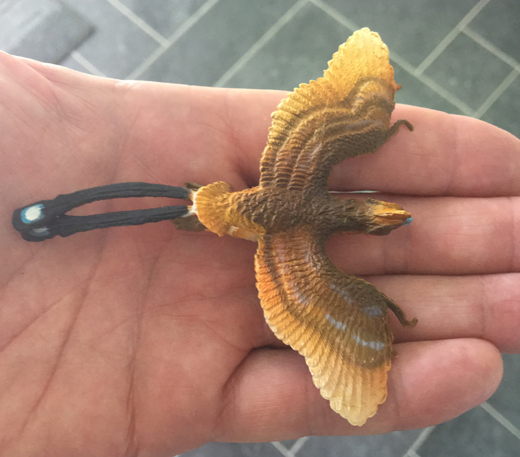“Wonderchicken” Fossil Reveals Origin of Modern Birds
The oldest fossil of a modern bird yet found, dating from the very end of the Cretaceous, has been identified by an international team of palaeontologists led by researchers from the University of Cambridge. Sophisticated CT scans (computerised tomography), of a limestone rock, not much bigger than a pack of cards, revealed the exquisitely preserved fossil skull. Fragments of bone exposed on the rock’s surface suggested that there were more bones buried deep in the rock, but the scientists were not expecting to find the near perfect fossilised skull of a modern bird (neornithine), once the CT scans had been completed.
Fossil Skull Study
The bird has been nicknamed “wonderchicken” as its skull shows characteristics found in modern ducks and chickens. This suggests it is close to the last common ancestor of these types of birds.
An Early Bird in the Hand – Confuciusornis Model
Picture credit: Everything Dinosaur
The picture (above) shows a PNSO early bird model (Confuciusornis).
To view this range: PNSO Prehistoric Animal Models.
The fossil comes from a limestone quarry on the Netherlands-Belgium border, making it the first modern bird from the age of dinosaurs to have been found in the Northern Hemisphere.
Named Asteriornis maastrichtensis, this quail-sized bird (to which it is distantly related), exhibits a previously undocumented combination of galliform-like (landfowl) and anseriform-like (waterfowl) anatomical traits. Its presence alongside a previously reported Ichthyornis-like bird from the same quarry provides direct evidence of the co-occurrence of crown birds and avialan stem birds.
Small Size Could Have Saved Modern Birds from Extinction
Asteriornis was quite small, certainly much smaller than the pterosaurs that it shared the skies with. The fossil has been dated to 66.8-66.7 million years ago, a few hundred thousand years before the dinosaurs and lots of other animals including many types of bird, died out.
The authors of the scientific paper (published in the journal Nature), speculate that as it was small and it lived by the sea, this way of life, fitting a particular niche in the Late Cretaceous ecosystem, may have helped the ancestors of today’s birds to survive the end-Cretaceous mass extinction event that wiped out the dinosaurs.
The Everything Dinosaur website: Everything Dinosaur.


